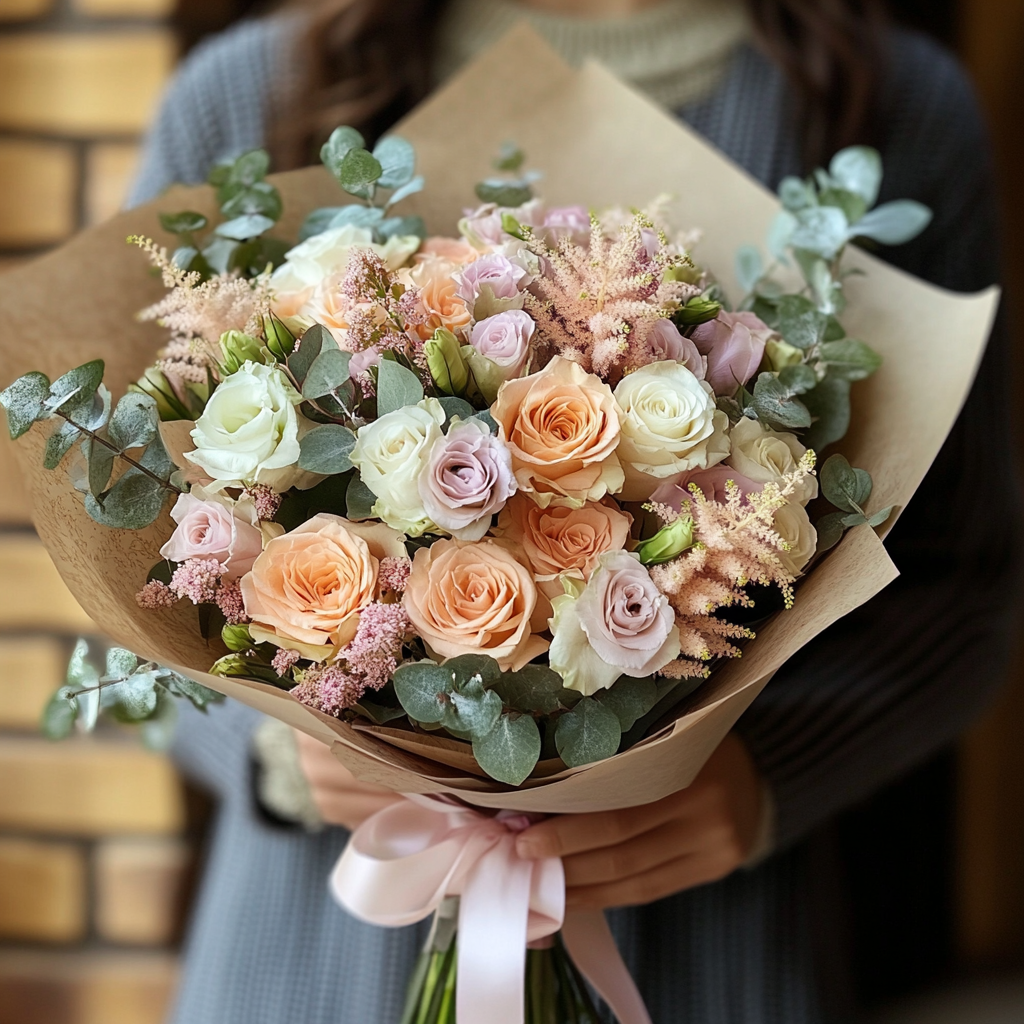Creating a beautiful hand-tied bouquet is one of the most rewarding floral skills you can learn. This versatile technique works for everything from simple fresh flower bouquets to elaborate wedding arrangements, and mastering it opens doors to countless creative possibilities. Hong Kong’s flower markets provide perfect materials for practicing this timeless art.

Understanding Hand-Tied Basics
A hand-tied bouquet is exactly what it sounds like – flowers arranged and secured while held in your hand, creating a natural, organic shape. Unlike arrangements created in vases or foam, hand-tied bouquets rely on the natural fall of stems and flowers to create their form. This technique produces bouquets with a relaxed, garden-picked appearance that’s particularly popular for modern celebrations.
The beauty of hand-tied bouquets lies in their versatility. Whether you’re creating birthday bouquets, anniversary flowers, or even graduation bouquets, the same basic technique applies. The key differences lie in flower selection, color combinations, and final finishing touches.
Essential Tools and Materials
Before beginning, gather your materials. You’ll need sharp floral scissors or secateurs, floral tape or elastic bands for securing, ribbon for finishing, and of course, your chosen flowers. Professional florists often use floral wire for delicate stems, but beginners can achieve excellent results with careful handling and proper technique.
Flower selection matters significantly for beginners. Sturdy flowers like roses, carnations, and sunflowers forgive handling mistakes better than delicate varieties. Many Hong Kong workshops start students with rose bouquets because roses offer the perfect combination of beauty and durability for learning.
Step-by-Step Process
Step 1: Preparation Remove all leaves from the lower two-thirds of each stem. This prevents bacterial growth and creates cleaner lines. Cut stems at an angle under running water, ensuring each stem is approximately the same length – typically 12-15 inches for standard bouquets.
Step 2: Creating Your Foundation Start with your focal flowers – these are typically your largest or most important blooms. For red rose bouquets, begin with three to five roses held in your non-dominant hand. Position them at slightly different heights to create natural variation.
Step 3: Adding Layers Working in a spiral pattern, add flowers one at a time, rotating the bouquet slightly with each addition. This spiral technique is crucial – it prevents stems from crossing and creates the characteristic dome shape of professional bouquets. Each new stem should cross the previous stems at the same angle.
Step 4: Incorporating Filler Flowers Once your focal flowers are positioned, add secondary flowers and foliage. For mother’s day carnation bouquets, you might add baby’s breath or eucalyptus between the main blooms. Continue the spiral pattern, maintaining the same crossing angle for all stems.
Step 5: Final Adjustments Hold the bouquet at arm’s length to assess balance and proportion. Gently push flowers higher or lower to create a pleasing dome shape. The bouquet should look full from all angles while maintaining a natural, organic appearance.
Step 6: Securing the Stems Once satisfied with the arrangement, secure the stems with floral tape or elastic band approximately 3-4 inches below the flower heads. Wrap firmly but not so tightly as to damage the stems.
Step 7: Final Trim Cut all stems to the same length, typically leaving 6-8 inches below the binding point. Cut stems under running water at a sharp angle to ensure proper water uptake.
Step 8: Finishing Touches Wrap the binding point with beautiful ribbon, securing with floral pins or by tying. Choose ribbon colors that complement your flowers – white or cream for elegant arrangements, bright colors for celebration flowers, or metallic tones for luxury roses.
Common Beginner Mistakes
Many beginners create bouquets that are too tight or too loose. The goal is controlled fullness – flowers should touch but not be crushed together. Another common error is inconsistent stem angles, which creates an uneven, unprofessional appearance.
Overhandling flowers can damage delicate petals. Work efficiently and gently, making decisions quickly rather than constantly rearranging. Trust your initial instincts about flower placement.
Adapting for Different Occasions
Romantic Occasions call for classic techniques with roses, peonies, or other romantic blooms. Flowerbee-hk style arrangements often feature soft, flowing ribbons and delicate color combinations perfect for valentines day bouquets or engagement celebrations.
Casual Celebrations might feature sunflower bouquets with more relaxed finishing. These arrangements can handle bolder ribbons and more varied flower types, perfect for graduation sunflower bouquets or cheerful birthday surprises.
Formal Events require precise technique and elegant flowers. Wedding flower arrangements demand particular attention to symmetry and proportion, while maintaining the natural beauty that makes hand-tied bouquets so appealing.
Seasonal Considerations
Hong Kong’s climate affects flower availability and bouquet longevity. Summer arrangements benefit from hardy flowers and might require additional care to prevent wilting. Winter bouquets can incorporate more delicate flowers that might not survive summer heat.
Understanding seasonal flower availability helps create more affordable and longer-lasting arrangements. Local flowers typically offer better value and longevity than imported varieties.
Practice and Improvement
Like any skill, creating beautiful hand-tied bouquets requires practice. Start with simple combinations – perhaps three types of flowers in complementary colors. As confidence grows, experiment with more complex combinations and varied textures.
Many beginners find success starting with monochromatic arrangements before attempting complex color combinations. A bouquet of red flowers in various shades and textures can be more striking than a rainbow arrangement that lacks cohesion.
Cultural Adaptations
In Hong Kong, hand-tied bouquets often incorporate elements reflecting local preferences. Understanding flower symbolism in Chinese culture can inform your choices, creating arrangements that are both beautiful and culturally appropriate.
Mastering hand-tied bouquet techniques provides a foundation for all other floral skills. Whether creating simple gratitude flowers or elaborate bridal gifts, these fundamental techniques ensure professional-looking results that bring joy to both creator and recipient.
